Not that we’ll know what to hunt. But we leave anyway, for the prospect of finding food tears us from our sanity. And in an effort to look every bit the expert huntsman, we take an empty rucksack, just in case.
Only a few hundred years ago we’d have known what we were likely to catch. We would have avoided the nasties that make us sick and steered clear of things that could fight back; then headed home with some morsel or other of tasty wildness.
In some parts of the world, the lost age of the hunter-gatherer still hangs in the air. But for us first-world peeps (with the exception of one or two), we have traded in the poison-tipped arrow and knowledge of nature’s fruits for Walmart.
As a consequence, we may be able to say what constitutes a venomous animal, but if we had to eat something wild for real, would we really know whether it is poisonous? Probably not.
Of course, one approach to such a crucial life-or-death humdinger would be to ask a friend to munch something like a cockroach and watch what happens. The other, kinder route is to read today’s listicle.
Behold — 15 animals you didn’t know we couldn’t eat (and also a couple of techniques by which we will beat the hand of God).
15. Puffer Fish Spoiler
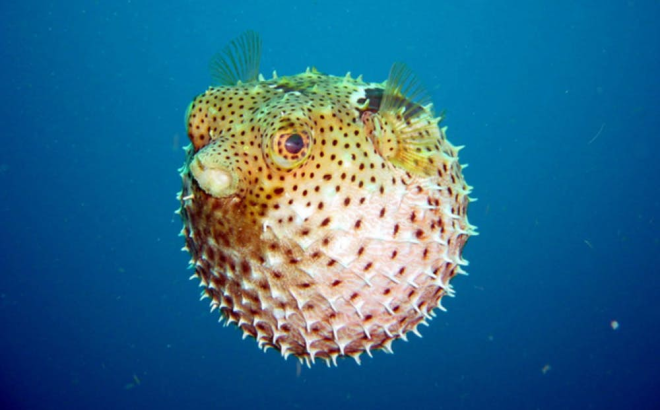
Puffer fish are found mostly in waters along tropical coasts and in the rivers of Africa. They have little spines dotted around their fleshy bodies that protect them from being eaten. They also have the ability to inflate like a miniature balloon when they sense they are in danger. The contents of their bodies are so intensely poisonous that if a human ingested just one ounce of the wrong part of a puffer fish, they would die a miserable death.
If we ingested puffer fish toxin, we would first feel a numbing of our tongue and lips followed by vomiting, suffocation, and paralysis. Certain death follows anywhere between 4 to 24 hours after eating, with no known cure. In Japan, however, the raw fish is served as a dish called fugu. Luckily, most Japanese chefs are highly skilled in its preparation.
14. Barracuda Butcher

Again to the seas of the tropics where this time, we meet the barracuda. This aggressive fish is serpentine in shape with razor-sharp teeth and the appetite of a piranha. It’s one of the most ferocious fish known and beats hands down the attitude of any shark. But, its love of fish that feed on a certain plankton called dinoflagellates means that it is highly susceptible to a foodborne illness called ciguatera.
Once the barracuda contracts ciguatera, its body is bloated with different types of toxins which is deadly to us. The one we should be most worried about though is ciguatoxin. Eating meat contaminated with this can cause almost the same symptoms brought on by eating a puffer. It can be fatal and there is no antidote. Crucially, ciguatoxin is not destroyed by conventional cooking techniques.
13. European Quail Rub Out

The European quail makes its nests in the ground. As such, it’s only natural for it to feed on whatever is lying around it. We are likely to finds things like insects, seeds, and fruits in the quail’s picnic hamper.
Some of us like to eat quail. It has a richer taste than chicken with a slightly meatier texture, too. Roasted quail is reportedly a favourite of the Queen of England when she visits Bellamy’s Restaurant in London.
But Her Majesty should perhaps be more careful in the future. According to reports, three men in Turkey died after eating roasted quail. Their symptoms prior to death include paralysis and suffocation. The likely cause hemlock poisoning, for one of the most favoured seeds of the quail is that of the hemlock and the toxins released into the bird cannot be cooked out.
12. Common Toad Dispatch
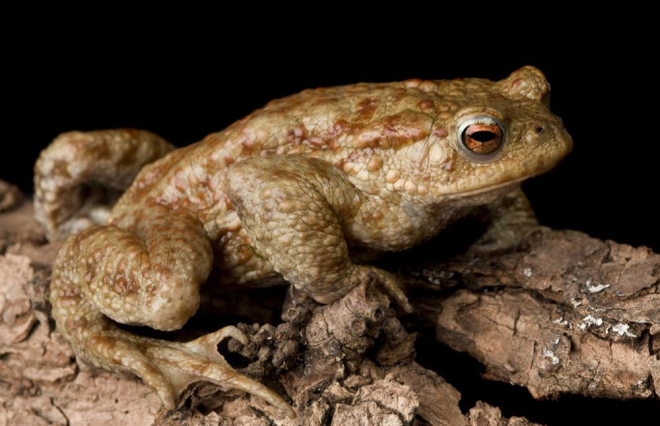
When you ask, “Has anyone else eaten toad?” And someone says, “Yes, I did. Last week.” You’ll know they’re lying. If they had, they would have spent the last seven days trying to breathe, struggling to walk, choking on their own vomit, and eventually dying. Yes, it’s true! Little do people realize that the common toad is one of our most villainous murderers. Yet, people continue to eat toads.
The secretions from a toad’s mouth are highly toxic to us. So, don’t go kissing a toad, either. But even if we touched a toad with the tip of our finger, we should ask to be taken to the nearest emergency room ASAP. Sadly, dogs are the most common victim of the toxicity of a toad, since many of our little friends love to chase things that hop around the garden.
11. Triggerfish Take Out

The triggerfish is another tropical sea dweller and is especially common in the Indian Ocean and Pacific Ocean. They are nice to look at, but not very welcoming. In fact, they are known to be as aggressive toward divers as barracudas are. Most notably bad-tempered when we encroach on their nesting sites which tend to be built in cones toward the surface of shallow coral reefs.
The triggerfish’s diet consists mainly of ocean bottom-feeders that protect themselves with spines (such as sea urchins). This may be responsible for the contamination of some triggerfish with a toxin called palytoxin, a chemical that can kill a human being. Palytoxin constricts the blood vessels and changes the chemical compounds in our cells, which makes staying alive really difficult.
If you feel yourself getting dizzy, sick, and out of breath after a meal of triggerfish, you may have a difficult road ahead.
10. Foul Play
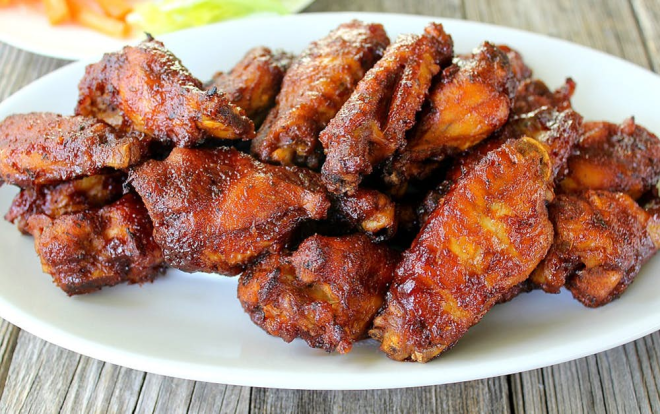
Why do most meat eaters like chicken? It’s reasonably bland and exceptionally versatile. Chickens have been around for years, but they were never as big as they are now. Roughly 50 years ago, the average chicken was a quarter of the weight it is now (imagine what they will look like in another 50 years). In the kitchen of Henry VIII, a chicken would have been at least half as small as we are used to.
A dubious report back in 2016 concluded that eating chicken wings was not wise for women who wanted to avoid ovarian cysts. According to House and Family Tips, the steroids that today’s pudgier chickens are injected with is collected in their wings and cannot be destroyed through cooking. The high concentration of steroids found in the wings, some believed, was linked to the growth of cysts on ovaries.
9. Polar Bear Wipe Out
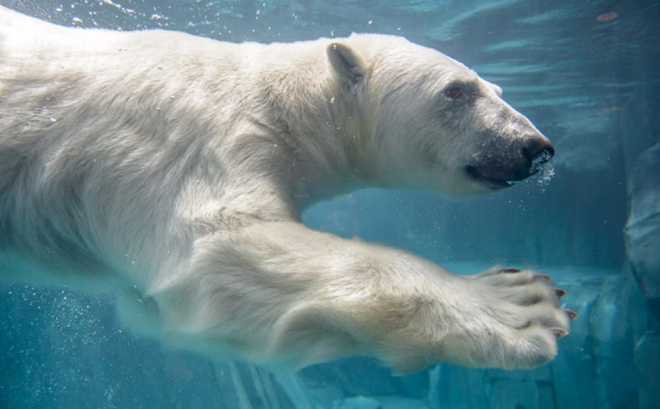
It’s more likely that we would be eaten by a polar bear than ever get a chance to eat one ourselves. Polar bears are notoriously aggressive and have a knack of stalking us. It’s often been remarked by those who have fallen foul of such tactics that a night on the polar cap can quickly turn to vinegar with the arrival of a hungry bear.
If we ever got a chance to munch one of these brutes, though, we would be best advised by Sven, our guide, to steer clear of its liver. Due to a high concentration of vitamin A, a spoonful of a polar bear’s liver will soon have us in Hypervitaminosis A, leading to a nasty mix of liver failure, bone damage, vomiting, and headaches.
8. Spur-Winged Goose Garotte
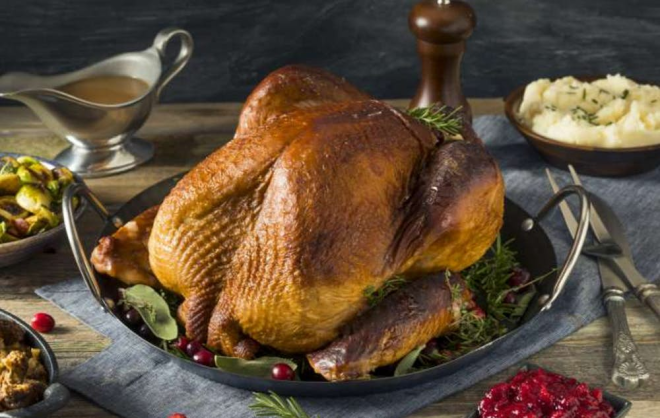
Although the African spur-winged goose makes for quite a picture, it’s neither friendly nor safe to eat. The bird has a terrible temper during mating season and will attack any animal that strays too close to its nest, no matter its size. If caught and killed, it also has a means of getting back at its predator. Because the goose eats mostly blister beetles, its body stores a high concentration of cantharidin, a poison that is resistant to cooking, and just 10 mg of cantharidin can kill a human.
In North America, a similar phenomenon was noted of the ruffed grouse. Some of the American medical journals from the 19th century reported many cases of poisoning in patients who ate the bird in the winter months. They later concluded that they were poisoned because the birds had dined on plants that harbored toxins resistant to cooking.
7. San-nakji Slaying
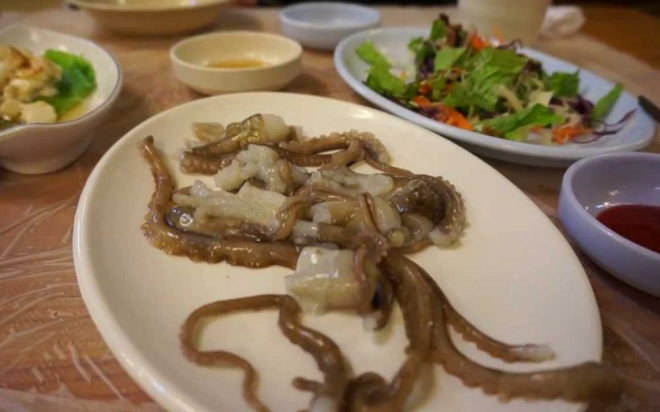
The Koreans are known for their outlandish cooking methods and the animals they eat. Their diet will sometimes raise eyebrows, because unlike us (with our sensitivities), they consider most things that move fair game. San-nakji is a dish of fresh octopus called the nakji. The nakji’s fate is a miserable one after being caught. It is cut up while still living, lightly seasoned, and eaten. If prepared “expertly” enough, the octopus pieces will still be moving as the plate is brought to the table.
The nakji has a unique means of revenge, though. It does not harbour a toxin, nor does it have naturally poisonous flesh, but it does have suckers in abundance and it is this feature that it uses to good effect on dozens of people each year. Unsuspecting diners have succumbed to choking on many occasions and that, friends, is karma.
6. Gold Dart Frog Felony
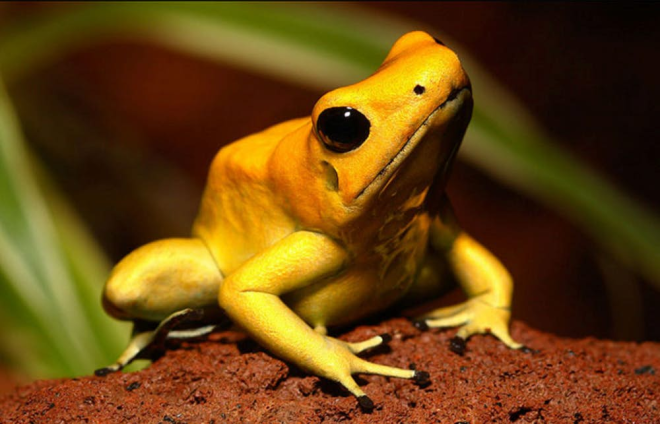
The gold dart frog, at two-inches long, is one of the world’s most poisonous creatures. It’s found in the depths of the Colombian rainforest and has been sought for centuries by the forest’s tribes for its lethal juices. The gold dart frog is a member of the poison dart frog family of which there are over 245 members, each posing a threat to whoever may be dumb enough to eat them.
People who have either eaten them through desperation or in some other way come into contact with their skin have died. That’s because the frog poison that is exuded from cells on the amphibian’s skin is an extremely powerful nerve toxin. In fact, scientists estimate that one milligram of frog poison entering a human is deadly. In other words, one frog can kill 20 men.
5. Blood Clams Bloodshed
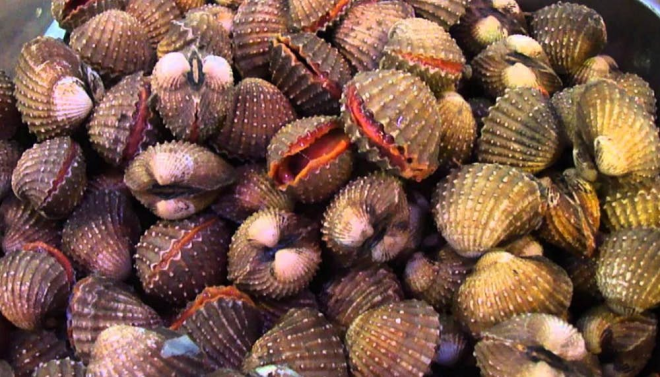
Blood clams are a type of shellfish found in the shallow waters of the Indian Ocean and Pacific Ocean around Africa, India, China, and Japan. They are called so because they have haemoglobin in their bodies just like us (and haemoglobin is red when oxygenated). It is the habitat of the clams that creates the perfect storm for those diners who like to eat their blood clams raw or boiled.
Due to the fact that they bury themselves under the sand of shallow water, the clams will invariably be found living near our coastal settlements. Since the coasts are heavily populated, the water filtered by the clams for food will sometimes contain high levels of human and animal waste. What this adds up to is a “dirty” clam with a concentrated stomach containing all manner of baddies such as dysentery and typhoid.
4. Cone Shell Carnage

The cone shell is widely regarded as the most dangerous shellfish on the planet. While smaller cone snails might lash out at a human and cause no more than the equivalent pain of a bee sting, the larger types found in the Indian Ocean will kill. The snail has a harpoon-like tongue protruding from its mouth that comes complete with a venomous gland. It injects a powerful nerve toxin into its prey, which for smaller animals, causes death within seconds.
One drop of the venom from the snail can kill more than 20 humans. It causes paralysis and respiratory failure, and there is no known antidote as of yet. Despite the risks, cone shells are quite a delicacy in the Philippines and are served as a creamy soup. But they have to be prepared properly; the venom duct must be removed carefully so as not to contaminate the surrounding tissue.
3. Blister Beetle Strangle
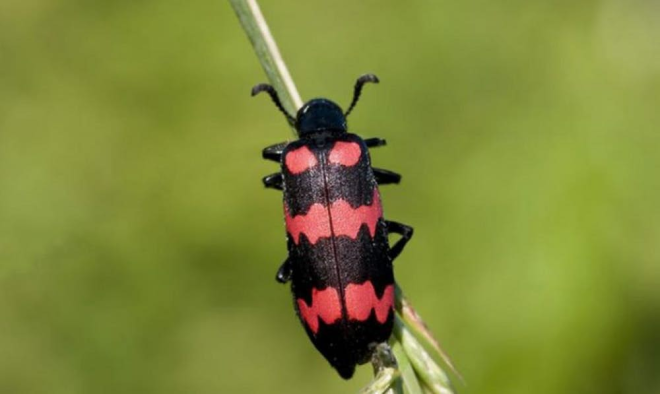
Although it’s unlikely that any of us would be stupid enough to eat a blister beetle, stranger things have happened. Young children, especially, are at risk from this critter if they are foraging in gardens found in the drier regions of the United States. The blister beetle uses a defensive toxin called cantharidin, a burning agent with a widespread application in the treatment of skin warts.
Ingesting the blister beetle can be a serious business and cases have been reported of patients vomiting blood, falling unconscious, and suffering from kidney failure. The cantharidin toxin attacks the circulatory system of the victim. It’s thought that just one milligram per kilogram of bodyweight is a sufficient quantity to kill. However, once the cause of the symptoms is realized, swift medical treatment will cure the condition.
2. Jellyfish Liquidate
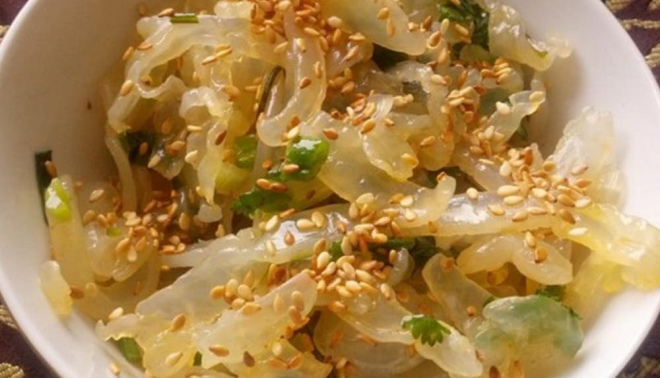
There are around 2,000 species of jellyfish in the world. Most of them are made with tentacles covered in venom-filled barbs that can sting even when detached from the fish. So watch out! In 2009, the Portuguese man-of-war was responsible for 10,000 human stings in waters around Australia, according to the Medical Journal of Australia.
Jellyfish are also considered quite the delicacy by some cultured chefs. When serving jellyfish at restaurants, they make sure the animal is prepared carefully with all the venomous parts removed, otherwise — depending on the type of fish — it will be game over. One naughty little critter called the Irukandji jellyfish, about the size of a lava bean, is fatal if swallowed. It is thought of as one of the most venomous jellyfish in the world. In the worse cases, victims take weeks to die.
1. Auger Shell Slaughter
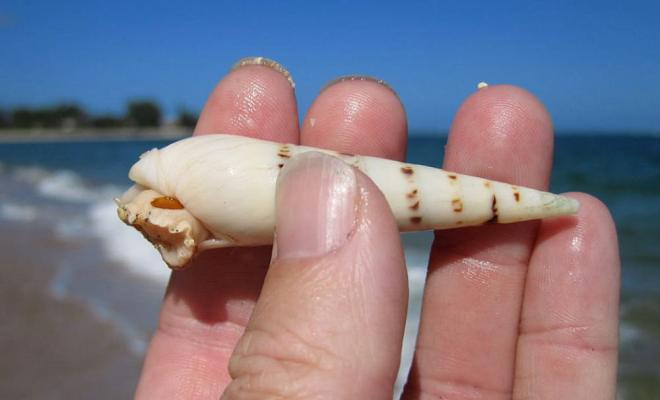
With the same feeding habits as the cone shell, the auger is another shellfish to be avoided if enjoying some scuba in the Indian Ocean. Its venomous tongue barb is usually put to good use against small fish and other molluscs, but once in a while, it will find a human target (it doesn’t search out humans, but it will strike if one gets too close). Sometimes, a shell collector will end up at the business-end of an auger shell strike if they pick up a shell believing it to be empty.
An auger shell can be eaten if, as with other carnivorous shellfish, its venomous parts are taken out first. Auger shells are apparently served up safely in the Philippines. Visiting a wet market in towns such as Coron can be a shellfish-lovers paradise, but knowing your shells is a matter of life and death.

